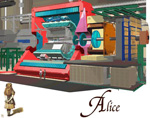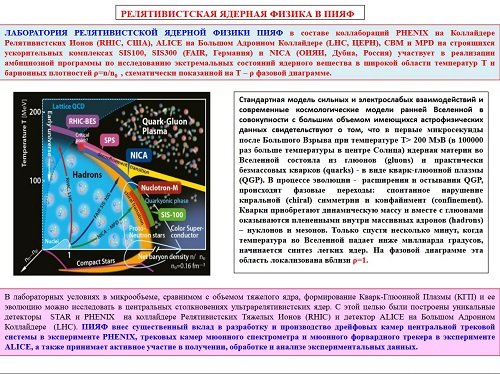 Great discoveries in the history of physics have frequently been associated with study of matter under extreme conditions.
The physics of small sizes requires the quantum mechanical principles while the physics of high velocities requires the special
relativity.
Experiments with the high energy central heavy ion collisions performed in the last decades of past
century at CERN
indicated closing to a new exciting threshold: onset of deconfinement and the chiral
symmetry restoration in nuclear matter at high energy density. The strong interaction theory,
Quantum ChromoDynamics (QCD), and the lattice calculations predicted that at sufficiently high temperatures
the hadronic matter will undergo transition to a state in which the quarks and gluons, usually
localized inside the hadrons, become locally unbound. It results in a new extreme phase of matter,
the gluon dominated Quark-Gluon Plasma (QGP), which probably was a state of the Universe in the first
few microseconds following the Big Bang. On the other hand significant increase of the baryon density
at comparatively low temperatures should lead to creating of the quark plasma expected to exist
in the core of the neutron stars. Investigations in the laboratory conditions of these extreme new
states of matter are listed in the Long-Range Plan for Nuclear Physics as the highest priority
problems.
Great discoveries in the history of physics have frequently been associated with study of matter under extreme conditions.
The physics of small sizes requires the quantum mechanical principles while the physics of high velocities requires the special
relativity.
Experiments with the high energy central heavy ion collisions performed in the last decades of past
century at CERN
indicated closing to a new exciting threshold: onset of deconfinement and the chiral
symmetry restoration in nuclear matter at high energy density. The strong interaction theory,
Quantum ChromoDynamics (QCD), and the lattice calculations predicted that at sufficiently high temperatures
the hadronic matter will undergo transition to a state in which the quarks and gluons, usually
localized inside the hadrons, become locally unbound. It results in a new extreme phase of matter,
the gluon dominated Quark-Gluon Plasma (QGP), which probably was a state of the Universe in the first
few microseconds following the Big Bang. On the other hand significant increase of the baryon density
at comparatively low temperatures should lead to creating of the quark plasma expected to exist
in the core of the neutron stars. Investigations in the laboratory conditions of these extreme new
states of matter are listed in the Long-Range Plan for Nuclear Physics as the highest priority
problems.

From the beginning of this century the
Relativistic Heavy Ion Collider (RHIC) at
BNL (USA) entered this new
field of studies creating collisions of the gold ion beams with the energy 100 A GeV each.
The principle goal of the
PHENIX ,
STAR ,
PHOBOS and
BRAHMS experiments at
RHIC was the discovery and
characterization of the QGP at high temperatures. Basing on the property of asymptotic freedom of
the QCD it was expected to observe at the RHIC energies the QGP as the dense gas medium of weakly
interacting quarks and gluons. During the decade of the RHIC operation a huge amount of data was
accumulated and processed which opposite to the common expectation led to a conclusion that the
properties of the medium created in the high energy central heavy ion collisions are more close
to properties of the dense almost perfect liquid characterized by strong interaction of constituents.
The detailed studies of the GQP formation are now continuing at the RHIC and at
LHC in
CERN
where the energy of the colliding ions of lead are exceeding energy at RHIC by more than 20 times.
The other limit, high baryon density but low temperature region of the phase diagram will be studied
in the heavy ion collisions at FAIR and NICA facilities starting from 2016.
The PNPI is active participant in almost all collaborations
involved in these studies.
For more information about the activities of RELATIVISTIC NUCLEAR PHYSICS, see the page of the website of the
Laboratory of Relativistic Nuclear Physics
and here (see the full text of the file from 3 pages in a separate window):

